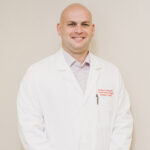Request an appointment with the UofL Health – Reflux, Swallowing and Hernia Center by calling 502-588-4571. Our nurse navigator, Kelsey Schneider, is available to assist you with any questions and get you scheduled with our specialists.
What is a hernia?
A hernia is a hole in the abdominal wall (the muscular sac) through which bowel, fat or other abdominal contents can get stuck or potentially escape.
Hernias can be congenital (born with) or acquired (developed over time) and there are many types.
What are the different types of hernias?
A few types of hernias include:
- Inguinal or groin hernias– These are most common in men and present as bulges in the groin. Fatty tissue or a part of the intestine irritates the groin at the top of the inner thigh and causes occasional pain.
- Incisional hernias– Develop after some form of operation when tissue protrudes through a scar. Anytime an incision is created on the abdomen after a procedure, a situation for a predisposed hernia can occur.
- Umbilical or “belly button” hernias– When fatty tissue pushes through the abdomen near the belly button, we call this an umbilical hernia. These are frequently present in children but also common in adults.
- Hiatal hernias– These are a special kind of hernia where the stomach escapes into the chest and predisposes patients to reflux and other clinical conditions which require surgical intervention. This kind of hernia should be fixed by a surgeon who specializes in surgery of the esophagus and the stomach.
Learn more at: https://UofLHealth.org/Articles/Hernias-Types-Common-Symptoms/
What are the treatment options for a hernia?
There is no medical management for hernias.
Surgical treatments vary depending on the kind of hernia:
- Groin hernias can be fixed using the open technique, or minimally invasively, using the laparoscopy or the daVinci robot, depending on the surgeon's skills, the size of the hernia, and the availability of the robot.
- Incisional hernias and belly button hernias are repaired laparoscopically or open, depending on the size of the hernia. Sometimes, the big defects need specialized surgeries where the abdominal wall is reconstructed. Abdominal wall reconstruction may be performed when the incisional hernia is so large that splitting of the abdominal wall muscles is necessary to reconstruct the abdominal wall and treat the hernia. This is best done at hernia centers, like UofL Health. The abdominal wall reconstruction is typically performed utilizing transversus abdominis release (posterior component separation) or external oblique release (anterior component separation). Both procedures are performed at UofL Health, a high-volume center for these procedures.
- Hiatal hernias (or para esophageal hernias) are a special kind of hernia leading to reflux and swallowing problems. Patients cannot see these hernias, unlike the previously described ones. Symptoms of these hernias include heartburn, regurgitation, chest pain and difficulty swallowing. These hernias should ideally be treated by surgeons who have done extra training and are usually repaired laparoscopically.
What is a hiatal hernia?
A hiatal hernia occurs when part or all of the stomach migrates up into the chest, predisposing patients to heartburn, chest pain, and transit of stomach contents up into the food pipe.
What is an antireflux surgery?
Antireflux surgery corrects the hiatal hernia and utilizes part of the stomach to reinforce the valve separating the stomach from the esophagus.
What is a hernia?
A hernia is a hole in the muscles of the abdomen through which fat, intestines and other abdominal structures protrude and cause pain, obstruction, or other surgical problems and/or emergencies.


 UofL Health – Chestnut Street Outpatient Center
UofL Health – Chestnut Street Outpatient Center








